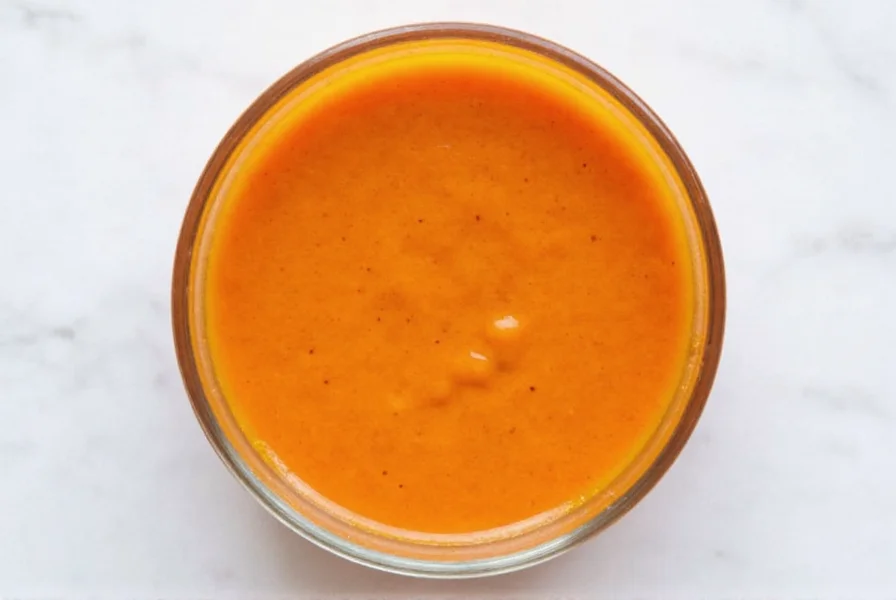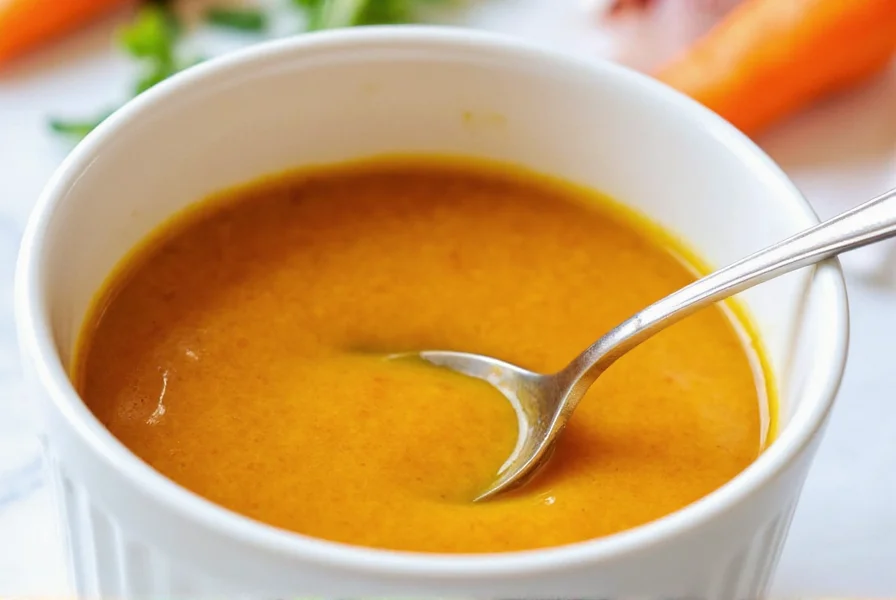Carrot ginger salad dressing has emerged as a kitchen staple for health-conscious cooks seeking flavorful alternatives to store-bought options. Unlike commercial dressings loaded with preservatives and added sugars, this homemade version harnesses the natural sweetness of carrots while delivering anti-inflammatory benefits from fresh ginger. The dressing's versatility extends beyond traditional salads—it complements grain bowls, roasted vegetables, and even serves as a light marinade for proteins.
Essential Ingredients Breakdown
Creating exceptional carrot ginger dressing requires understanding each component's role. While recipes vary, these core ingredients form the foundation of a balanced dressing:
| Ingredient | Function | Recommended Quantity | Substitution Options |
|---|---|---|---|
| Fresh carrots | Natural sweetness and vibrant color | 1 cup (120g) grated or steamed | Butternut squash puree (milder flavor) |
| Fresh ginger | Spicy warmth and digestive benefits | 1-2 tbsp grated (adjust to taste) | Ginger powder (1/4 tsp = 1 tbsp fresh) |
| Citrus juice | Acidity to balance sweetness | 3 tbsp lemon or orange juice | Apple cider vinegar (reduced quantity) |
| Healthy oil | Emulsification and richness | 1/4 cup avocado or olive oil | Tahini (for oil-free version) |
| Garlic | Flavor complexity | 1 small clove | 1/4 tsp garlic powder |
| Seasoning | Flavor enhancement | 1/4 tsp sea salt, black pepper | Adjust to taste |
Professional chefs emphasize using fresh carrots rather than pre-packaged grated varieties, which often contain preservatives affecting flavor. For optimal texture, steam carrots for 5 minutes before blending—they'll emulsify better than raw carrots while preserving nutrients. The ginger-to-carrot ratio determines your dressing's character: a 1:4 ratio creates subtle warmth, while 1:2 delivers bold ginger presence.
Step-by-Step Preparation Guide
Follow these professional techniques for perfectly balanced carrot ginger vinaigrette every time:
- Prepare vegetables: Peel and coarsely grate 1 cup of carrots. Peel 1-2 inches of ginger and mince finely.
- Steam carrots (optional but recommended): Place grated carrots in a steamer basket over boiling water for 5 minutes. This softens fibers for smoother blending.
- Combine ingredients: In a high-speed blender, add steamed carrots, ginger, 3 tbsp citrus juice, 1 small garlic clove, 1/4 cup oil, 1/4 tsp salt, and black pepper.
- Blend thoroughly: Start on low speed, gradually increasing to high. Blend for 60-90 seconds until completely smooth, scraping down sides as needed.
- Adjust consistency: For thicker dressing, reduce oil. For salad application, add 1-2 tbsp water if too thick.
- Rest before serving: Allow dressing to sit 30 minutes for flavors to meld. Shake or whisk before use.
Avoid common mistakes like over-blending (creates heat that alters flavor) or using cold ingredients straight from the refrigerator. Room temperature components emulsify more effectively. For food safety, always use clean equipment and consume within 5 days.
Flavor Profile and Perfect Pairings
This dressing offers a unique flavor journey: initial sweetness from carrots transitions to ginger's spicy warmth, finishing with citrus brightness. The texture should be creamy yet pourable—thicker than vinaigrette but lighter than ranch.
Maximize your dressing's potential with these pairing recommendations:
- Green salads: Combines beautifully with bitter greens like arugula or radicchio that balance the sweetness
- Grain bowls: Excellent with quinoa, farro, or brown rice bowls featuring roasted sweet potatoes and chickpeas
- Vegetable applications: Toss with roasted Brussels sprouts, drizzle over steamed broccoli, or use as a dip for raw vegetables
- Protein pairings: Complements grilled chicken, baked salmon, or tofu without overpowering delicate flavors
Seasonal variations enhance versatility—add orange zest in winter, fresh basil in summer, or a pinch of cayenne for extra heat. For meal prep enthusiasts, this dressing maintains quality when stored properly, making it ideal for weekly salad preparation.
Storage and Shelf Life Guidelines
Proper storage ensures your homemade carrot ginger salad dressing remains fresh and safe:
- Store in an airtight glass container in the refrigerator
- Consume within 5 days for optimal flavor and safety
- Separation is natural—simply shake or whisk before use
- Do not leave at room temperature for more than 2 hours
- Freezing is not recommended as it alters texture
Signs of spoilage include sour smell, mold development, or significant color change. When in doubt, discard the dressing. For extended freshness, add 1/2 tsp citric acid or extra citrus juice, which acts as a natural preservative.
Popular Variations for Dietary Needs
Adapt this basic recipe to accommodate various dietary preferences while maintaining excellent flavor:
- Vegan version: Already naturally vegan—ensure all ingredients are plant-based
- Oil-free alternative: Replace oil with 2-3 tbsp tahini or 1/4 cup unsweetened applesauce
- Lower sugar option: Reduce carrots by 25% and add 1/4 tsp turmeric for color
- Spicy variation: Add 1/4 tsp cayenne pepper or 1 small minced jalapeño
- Creamier texture: Include 2 tbsp plain Greek yogurt or coconut yogurt
For those following specific dietary protocols, this dressing naturally aligns with Mediterranean, Whole30 (with oil substitution), and anti-inflammatory eating patterns. The nutrient profile remains strong across variations, delivering vitamin A from carrots and gingerol compounds from fresh ginger.
Nutritional Benefits Overview
Unlike processed dressings, homemade carrot ginger vinaigrette offers meaningful nutritional advantages without making medical claims. One serving (2 tbsp) typically contains:
- Approximately 60-80 calories depending on oil content
- Natural beta-carotene from carrots (converts to vitamin A)
- Gingerol compounds with antioxidant properties
- Healthy monounsaturated fats from quality oils
- No added sugars or artificial preservatives
The dressing contributes to vegetable consumption goals by making salads more appealing. Its natural sweetness often helps those transitioning from sugary dressings to appreciate vegetables' inherent flavors. For balanced nutrition, pair with protein and fiber-rich salad components.

Frequently Asked Questions
Can I make carrot ginger dressing without a blender?
Yes, you can prepare carrot ginger salad dressing without a blender by using a fine grater and whisk. Steam and finely grate the carrots, then mince ginger extremely small. Whisk all ingredients vigorously in a bowl until emulsified. The texture will be slightly grainier but still delicious. For smoother results, press the mixture through a fine mesh sieve after whisking.
Why does my carrot ginger dressing separate?
Separation occurs naturally in oil-based dressings due to different densities of ingredients. This homemade carrot ginger vinaigrette lacks emulsifiers found in commercial products. Simply shake vigorously in a sealed container or whisk thoroughly before each use. Adding 1/2 tsp Dijon mustard during preparation can improve emulsification for those preferring less separation.
What's the best way to adjust sweetness in carrot ginger dressing?
To adjust sweetness in your carrot ginger salad dressing recipe, modify the carrot quantity—use less for reduced sweetness or add 1-2 tsp maple syrup for extra sweetness. The natural sugars in carrots provide the primary sweetness, so steaming time affects intensity (longer steaming increases sweetness). For sugar-free versions, increase citrus juice slightly to balance flavors without added sweeteners.
How can I make my carrot ginger dressing more tangy?
To enhance tanginess in your homemade carrot ginger dressing, increase citrus juice by 1-2 tablespoons or substitute part of the oil with apple cider vinegar. Adding 1/2 tsp of high-quality rice vinegar provides subtle complexity. For professional results, balance increased acidity with a small pinch of salt to prevent the dressing from becoming one-dimensional. Taste and adjust incrementally until desired tang level is achieved.
Can I use bottled ginger juice in carrot ginger salad dressing?
While fresh ginger is preferred for optimal flavor in carrot ginger salad dressing recipes, bottled ginger juice can work in a pinch. Use 1-2 teaspoons of high-quality ginger juice instead of fresh. Note that bottled versions often contain preservatives and lack the bright, complex flavor of fresh ginger. For best results, combine a small amount of bottled juice with freshly grated ginger to maintain depth of flavor while ensuring consistent ginger presence.











 浙公网安备
33010002000092号
浙公网安备
33010002000092号 浙B2-20120091-4
浙B2-20120091-4